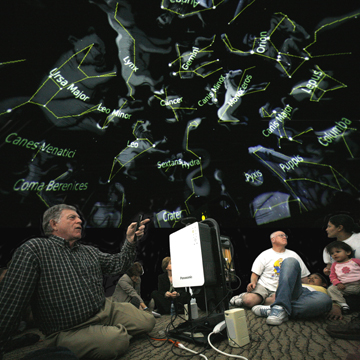School children in Livermore have seen a ring nebula up close. They’ve traveled across our solar system to Pluto and back again. They’ve visited other galaxies and seen the sun up close. All thanks to Sandia.

The Labs provided crucial funding in purchasing a Digitalis portable planetarium for the Livermore school district. The funding came through Lockheed Martin’s Gifts and Grants program, which Sandia/California distributes to organizations in the community.
“Bringing this incredible teaching tool into the local schools can hardly be more wonderful,” says Sandia Community Relations Officer Jim Simmons (8528). “There is a growing national concern about science education, which we can use our resources to address. This is a perfect example of what we want to accomplish in community relations.”
The planetarium is a simple device, consisting of a 10-by-16-foot dome tent, a projector, and a computer. Stellarium, an open-source planetarium program, provides the magic — the images of the stars, planets, and anything else you can find in space.
At a dedication ceremony for the planetarium, Livermore schools Superintendent Brenda Miller said, “This is what true education is — when you can bring a tool into the schools and generate so much excitement.”
Sandia not only provided the bulk of the funding for the planetarium, but also the brainpower to prepare the tool for use in the schools. The driver behind the planetarium effort was the Teaching Opportunities for Partners in Science (TOPS) program, which places retired scientists and engineers in the classroom.
The Livermore TOPS program includes retired engineers and scientists from Sandia, Lawrence Livermore National Laboratory, General Electric, and other local technology companies.
When several TOPS scientists borrowed a planetarium from the San Joaquin County Office of Education last year, they decided they had to have it for the Livermore schools. Cost was an issue, as the price tag for the planetarium is $25,000, plus operation and maintenance costs. Still, the TOPS scientists were well on their way with two donations of $5,000 each from General Electric and community member Prabha Duneja.
Jeff Manchester, manager of Public Relations and Strategic Communications Dept. 8528, recalls being asked if Sandia would kick in another $5,000.
“We decided we’d rather just solve the problem, and we donated $20,000 to complete the purchase,” he says. “The planetarium was a wonderful opportunity to provide a science-directed solution for elementary and middle school students.”
Sandia retiree Ken Mitchell was part of a team that spent several weeks in December preparing the planetarium for use in schools. The work included writing a user manual, testing the system, and developing scripts to guide teachers through lessons on the moon, distant galaxies, constellations, and planets.
Ken, who spent more than 40 years at Sandia working in stockpile engineering, has been working at Marylin Avenue Elementary School as a TOPS scientists since he retired in 2000. In January, he led lessons in the planetarium at Marylin.
“The students just love it. They say it’s the best science day they’ve ever had,” he says. “Most kids never even look at the sky at night, but after a lesson in the planetarium they can recognize the Big Dipper, Orion, and other constellations.”
When conducting lessons in the planetarium, Ken prefers to stray from the scripts for a more interactive experience. He’ll ask the kids questions about what they already know and use that as a basis for delving deeper.
Ken thinks they’ve just touched the surface of the planetarium’s potential as a teaching tool. In addition to astronomy, there are also social studies lessons to be learned. The constellation script not only shows the major constellations, but also demonstrates how the Egyptian, Roman, Chinese, Hindu, Inuit, and Navajo cultures interpreted the stars.
Ken and other TOPS scientists are now working to develop more lessons based on the state content standards and applications for middle school students. In fact, the biggest limitation of the planetarium is time. With 10 elementary schools and four middle schools in Livermore clamoring for it, the planetarium has to move quickly between sites to give all students an opportunity.